Deck 33: An Introduction to Invertebrates
سؤال
سؤال
سؤال
سؤال
سؤال
سؤال
سؤال
سؤال
سؤال
سؤال
سؤال
سؤال
سؤال
سؤال
سؤال
سؤال
سؤال
سؤال
سؤال
سؤال
سؤال
سؤال
سؤال
سؤال
سؤال
سؤال
سؤال
سؤال
سؤال
سؤال
سؤال
سؤال
سؤال
سؤال
سؤال
سؤال
سؤال
سؤال
سؤال
سؤال
سؤال
سؤال
سؤال
سؤال
سؤال
سؤال
سؤال
سؤال
سؤال
سؤال
سؤال
سؤال
سؤال
سؤال
سؤال
سؤال
سؤال
سؤال
سؤال
سؤال
سؤال
سؤال
سؤال
سؤال
سؤال
سؤال
سؤال
سؤال
سؤال
سؤال
سؤال
سؤال
سؤال
سؤال
سؤال
سؤال
سؤال
سؤال
سؤال
سؤال

فتح الحزمة
قم بالتسجيل لفتح البطاقات في هذه المجموعة!
Unlock Deck
Unlock Deck
1/83
العب
ملء الشاشة (f)
Deck 33: An Introduction to Invertebrates
1
Which of the following can be found in the mesohyl of a sponge?
A) amoebocytes and choanocytes
B) spicules and choanocytes
C) amoebocytes and spicules
D) amoebocytes and polyps
A) amoebocytes and choanocytes
B) spicules and choanocytes
C) amoebocytes and spicules
D) amoebocytes and polyps
C
2
Use the following information to answer the question.
An elementary school science teacher decided to liven up the classroom with a saltwater aquarium. Knowing that saltwater aquaria can be quite a hassle, the teacher proceeded stepwise. First, the teacher conditioned the water. Next, the teacher decided to stock the tank with various marine invertebrates, including a polychaete, a siliceous sponge, several bivalves, a shrimp, several sea anemones of different types, a colonial hydra, a few coral species, an ectoproct, a sea star, and several herbivorous gastropod varieties. Lastly, she added some vertebrates-a parrot fish and a clown fish. She arranged for daily feedings of copepods and feeder fish.
Normally, the clown fish readily swims among the tentacles of the sea anemones; the parrot fish avoids them. One hypothesis for the clown fish's apparent immunity is that they slowly build a tolerance to the sea anemone's toxin. A second hypothesis is that a chemical in the mucus that coats the clown fish prevents the nematocysts from being triggered. Which of the following graphs supports the first, but not the second, of these hypotheses?
A)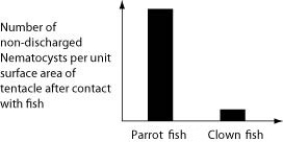
B)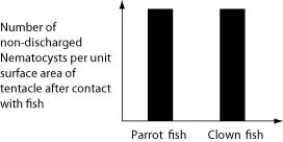
C)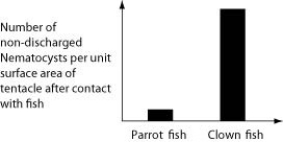
D)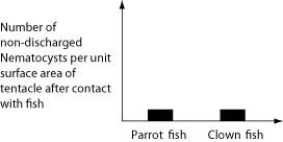
An elementary school science teacher decided to liven up the classroom with a saltwater aquarium. Knowing that saltwater aquaria can be quite a hassle, the teacher proceeded stepwise. First, the teacher conditioned the water. Next, the teacher decided to stock the tank with various marine invertebrates, including a polychaete, a siliceous sponge, several bivalves, a shrimp, several sea anemones of different types, a colonial hydra, a few coral species, an ectoproct, a sea star, and several herbivorous gastropod varieties. Lastly, she added some vertebrates-a parrot fish and a clown fish. She arranged for daily feedings of copepods and feeder fish.
Normally, the clown fish readily swims among the tentacles of the sea anemones; the parrot fish avoids them. One hypothesis for the clown fish's apparent immunity is that they slowly build a tolerance to the sea anemone's toxin. A second hypothesis is that a chemical in the mucus that coats the clown fish prevents the nematocysts from being triggered. Which of the following graphs supports the first, but not the second, of these hypotheses?
A)

B)

C)

D)

B
3
Use the following information to answer the question.
The phylum Cycliophora was discovered in 1995. They are tiny organisms that live in large numbers on the outsides of the mouthparts and appendages of lobsters. The feeding stage permanently attaches to the lobster via an adhesive disk and collects scraps of food from its host's feeding by capturing the scraps in a current created by a ring of cilia. The body is saclike and has a U-shaped intestine that brings the anus close to the mouth. Cycliophorans are coelomates, do not molt (though their host does), and their embryos undergo spiral cleavage.
Which of these, if discovered among cycliophorans, would cause the most confusion concerning our current understanding of cycliophoran taxonomy?
A) if the ciliated feeding ring is a lophophore
B) if embryos are diploblastic
C) if the body cavity is actually a pseudocoelom
D) if the organisms show little apparent cephalization
The phylum Cycliophora was discovered in 1995. They are tiny organisms that live in large numbers on the outsides of the mouthparts and appendages of lobsters. The feeding stage permanently attaches to the lobster via an adhesive disk and collects scraps of food from its host's feeding by capturing the scraps in a current created by a ring of cilia. The body is saclike and has a U-shaped intestine that brings the anus close to the mouth. Cycliophorans are coelomates, do not molt (though their host does), and their embryos undergo spiral cleavage.
Which of these, if discovered among cycliophorans, would cause the most confusion concerning our current understanding of cycliophoran taxonomy?
A) if the ciliated feeding ring is a lophophore
B) if embryos are diploblastic
C) if the body cavity is actually a pseudocoelom
D) if the organisms show little apparent cephalization
B
4
The presence of a lophophore in a newly discovered species would suggest that the species ________.
A) has an exoskeleton
B) grows by shedding its external covering
C) is motile
D) is a filter feeder
A) has an exoskeleton
B) grows by shedding its external covering
C) is motile
D) is a filter feeder

فتح الحزمة
افتح القفل للوصول البطاقات البالغ عددها 83 في هذه المجموعة.
فتح الحزمة
k this deck
5
Use the following information to answer the question.
An elementary school science teacher decided to liven up the classroom with a saltwater aquarium. Knowing that saltwater aquaria can be quite a hassle, the teacher proceeded stepwise. First, the teacher conditioned the water. Next, the teacher decided to stock the tank with various marine invertebrates, including a polychaete, a siliceous sponge, several bivalves, a shrimp, several sea anemones of different types, a colonial hydra, a few coral species, an ectoproct, a sea star, and several herbivorous gastropod varieties. Lastly, she added some vertebrates-a parrot fish and a clown fish. She arranged for daily feedings of copepods and feeder fish.
Normally, the clown fish readily swims among the tentacles of the sea anemones; the parrot fish avoids them. One hypothesis for the clown fish's apparent immunity is that they slowly build a tolerance to the sea anemone's toxin. A second hypothesis is that a chemical in the mucus that coats the clown fish prevents the nematocysts from being triggered. Which of the following graphs supports the second, but not the first, of these hypotheses?
A)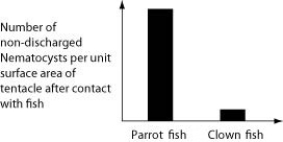
B)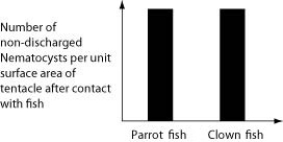
C)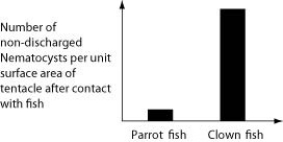
D)
An elementary school science teacher decided to liven up the classroom with a saltwater aquarium. Knowing that saltwater aquaria can be quite a hassle, the teacher proceeded stepwise. First, the teacher conditioned the water. Next, the teacher decided to stock the tank with various marine invertebrates, including a polychaete, a siliceous sponge, several bivalves, a shrimp, several sea anemones of different types, a colonial hydra, a few coral species, an ectoproct, a sea star, and several herbivorous gastropod varieties. Lastly, she added some vertebrates-a parrot fish and a clown fish. She arranged for daily feedings of copepods and feeder fish.
Normally, the clown fish readily swims among the tentacles of the sea anemones; the parrot fish avoids them. One hypothesis for the clown fish's apparent immunity is that they slowly build a tolerance to the sea anemone's toxin. A second hypothesis is that a chemical in the mucus that coats the clown fish prevents the nematocysts from being triggered. Which of the following graphs supports the second, but not the first, of these hypotheses?
A)

B)

C)

D)


فتح الحزمة
افتح القفل للوصول البطاقات البالغ عددها 83 في هذه المجموعة.
فتح الحزمة
k this deck
6
Use the following information to answer the question.
The phylum Cycliophora was discovered in 1995. They are tiny organisms that live in large numbers on the outsides of the mouthparts and appendages of lobsters. The feeding stage permanently attaches to the lobster via an adhesive disk and collects scraps of food from its host's feeding by capturing the scraps in a current created by a ring of cilia. The body is saclike and has a U-shaped intestine that brings the anus close to the mouth. Cycliophorans are coelomates, do not molt (though their host does), and their embryos undergo spiral cleavage.
Basing your inferences on information in the paragraph, to which clades should cycliophorans belong?
A) Eumetazoa and Bilateria
B) Eumetazoa and Lophotrochozoa
C) Deuterostomia and Ecdysozoa
D) Deuterostomia and Lophotrochozoa
The phylum Cycliophora was discovered in 1995. They are tiny organisms that live in large numbers on the outsides of the mouthparts and appendages of lobsters. The feeding stage permanently attaches to the lobster via an adhesive disk and collects scraps of food from its host's feeding by capturing the scraps in a current created by a ring of cilia. The body is saclike and has a U-shaped intestine that brings the anus close to the mouth. Cycliophorans are coelomates, do not molt (though their host does), and their embryos undergo spiral cleavage.
Basing your inferences on information in the paragraph, to which clades should cycliophorans belong?
A) Eumetazoa and Bilateria
B) Eumetazoa and Lophotrochozoa
C) Deuterostomia and Ecdysozoa
D) Deuterostomia and Lophotrochozoa

فتح الحزمة
افتح القفل للوصول البطاقات البالغ عددها 83 في هذه المجموعة.
فتح الحزمة
k this deck
7
Healthy corals are brightly colored because they ________.
A) secrete colorful pigments to attract mates
B) host symbionts with colorful photosynthetic pigments
C) build their skeletons from colorful minerals
D) secrete colorful pigments to protect themselves from ultraviolet light
A) secrete colorful pigments to attract mates
B) host symbionts with colorful photosynthetic pigments
C) build their skeletons from colorful minerals
D) secrete colorful pigments to protect themselves from ultraviolet light

فتح الحزمة
افتح القفل للوصول البطاقات البالغ عددها 83 في هذه المجموعة.
فتح الحزمة
k this deck
8
Use the following information to answer the question.
An elementary school science teacher decided to liven up the classroom with a saltwater aquarium. Knowing that saltwater aquaria can be quite a hassle, the teacher proceeded stepwise. First, the teacher conditioned the water. Next, the teacher decided to stock the tank with various marine invertebrates, including a polychaete, a siliceous sponge, several bivalves, a shrimp, several sea anemones of different types, a colonial hydra, a few coral species, an ectoproct, a sea star, and several herbivorous gastropod varieties. Lastly, she added some vertebrates-a parrot fish and a clown fish. She arranged for daily feedings of copepods and feeder fish.
The teacher and class were especially saddened when the colonial hydrozoan died. They had watched it carefully, and the unfortunate creature never even got to produce offspring by budding. Yet, everyone was elated when one of the students noticed a small colonial hydrozoan growing in a part of the tank far from the location of the original colony. The teacher was apparently unaware that these hydrozoans exhibit ________.
A) spontaneous generation
B) abiogenesis
C) alternation of generations
D) a medusa stage
An elementary school science teacher decided to liven up the classroom with a saltwater aquarium. Knowing that saltwater aquaria can be quite a hassle, the teacher proceeded stepwise. First, the teacher conditioned the water. Next, the teacher decided to stock the tank with various marine invertebrates, including a polychaete, a siliceous sponge, several bivalves, a shrimp, several sea anemones of different types, a colonial hydra, a few coral species, an ectoproct, a sea star, and several herbivorous gastropod varieties. Lastly, she added some vertebrates-a parrot fish and a clown fish. She arranged for daily feedings of copepods and feeder fish.
The teacher and class were especially saddened when the colonial hydrozoan died. They had watched it carefully, and the unfortunate creature never even got to produce offspring by budding. Yet, everyone was elated when one of the students noticed a small colonial hydrozoan growing in a part of the tank far from the location of the original colony. The teacher was apparently unaware that these hydrozoans exhibit ________.
A) spontaneous generation
B) abiogenesis
C) alternation of generations
D) a medusa stage

فتح الحزمة
افتح القفل للوصول البطاقات البالغ عددها 83 في هذه المجموعة.
فتح الحزمة
k this deck
9
Which of the following is most likely to be aquatic?
A) filter feeder
B) mass feeder
C) deposit feeder
D) fluid feeder
A) filter feeder
B) mass feeder
C) deposit feeder
D) fluid feeder

فتح الحزمة
افتح القفل للوصول البطاقات البالغ عددها 83 في هذه المجموعة.
فتح الحزمة
k this deck
10
You find what you believe is a new species of animal. Which of the following characteristics would enable you to argue that it is more closely related to a flatworm than it is to a roundworm?
A) It is a suspension feeder.
B) It has no coelom.
C) It is shaped like a worm.
D) It has a mouth and an anus.
A) It is a suspension feeder.
B) It has no coelom.
C) It is shaped like a worm.
D) It has a mouth and an anus.

فتح الحزمة
افتح القفل للوصول البطاقات البالغ عددها 83 في هذه المجموعة.
فتح الحزمة
k this deck
11
Use the graph to answer the following question.
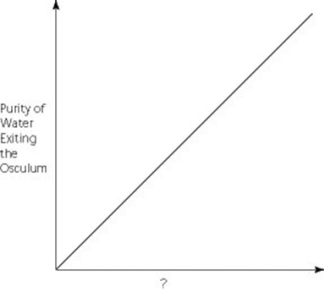
Which of the following factors, when used to label the horizontal axis of the graph, would account most directly for the shape of the plot?
A) rate of cribrostatin synthesis (molecules/unit time)
B) number of pores per sponge
C) number of spicules per sponge
D) number of choanocytes per sponge

Which of the following factors, when used to label the horizontal axis of the graph, would account most directly for the shape of the plot?
A) rate of cribrostatin synthesis (molecules/unit time)
B) number of pores per sponge
C) number of spicules per sponge
D) number of choanocytes per sponge

فتح الحزمة
افتح القفل للوصول البطاقات البالغ عددها 83 في هذه المجموعة.
فتح الحزمة
k this deck
12
What would be the best anatomical feature to look for to distinguish a gastropod from a chiton?
A) presence of a muscular foot
B) presence of a rasp-like feeding structure
C) production of eggs
D) dorsal plates
A) presence of a muscular foot
B) presence of a rasp-like feeding structure
C) production of eggs
D) dorsal plates

فتح الحزمة
افتح القفل للوصول البطاقات البالغ عددها 83 في هذه المجموعة.
فتح الحزمة
k this deck
13
Use the following information to answer the question.
The phylum Cycliophora was discovered in 1995. They are tiny organisms that live in large numbers on the outsides of the mouthparts and appendages of lobsters. The feeding stage permanently attaches to the lobster via an adhesive disk and collects scraps of food from its host's feeding by capturing the scraps in a current created by a ring of cilia. The body is saclike and has a U-shaped intestine that brings the anus close to the mouth. Cycliophorans are coelomates, do not molt (though their host does), and their embryos undergo spiral cleavage.
Which of these features is least useful in assigning the phylum Cycliophora to a clade of animals?
A) having a true coelom as a body cavity
B) having a body symmetry that permits a U-shaped intestine
C) having embryos with spiral cleavage
D) lacking ecdysis (molting)
The phylum Cycliophora was discovered in 1995. They are tiny organisms that live in large numbers on the outsides of the mouthparts and appendages of lobsters. The feeding stage permanently attaches to the lobster via an adhesive disk and collects scraps of food from its host's feeding by capturing the scraps in a current created by a ring of cilia. The body is saclike and has a U-shaped intestine that brings the anus close to the mouth. Cycliophorans are coelomates, do not molt (though their host does), and their embryos undergo spiral cleavage.
Which of these features is least useful in assigning the phylum Cycliophora to a clade of animals?
A) having a true coelom as a body cavity
B) having a body symmetry that permits a U-shaped intestine
C) having embryos with spiral cleavage
D) lacking ecdysis (molting)

فتح الحزمة
افتح القفل للوصول البطاقات البالغ عددها 83 في هذه المجموعة.
فتح الحزمة
k this deck
14
In terms of food capture, which sponge cell is most similar to the cnidocyte of a cnidarian?
A) amoebocyte
B) choanocyte
C) epidermal cell
D) pore cell
A) amoebocyte
B) choanocyte
C) epidermal cell
D) pore cell

فتح الحزمة
افتح القفل للوصول البطاقات البالغ عددها 83 في هذه المجموعة.
فتح الحزمة
k this deck
15
The sharp, inch-long thorns of the crown-of-thorns sea star are its spines. These spines, unlike those of most other sea stars, contain a potent toxin. If it were discovered that crown-of-thorns sea stars do not make this toxin themselves, then the most likely alternative would be that this toxin is ________.
A) derived from the nematocysts of its prey
B) absorbed from the surrounding seawater
C) an endotoxin of cellulose-digesting bacteria that inhabit the sea star's digestive glands
D) injected into individual thorns by mutualistic corals which live on the aboral surfaces of these sea stars
A) derived from the nematocysts of its prey
B) absorbed from the surrounding seawater
C) an endotoxin of cellulose-digesting bacteria that inhabit the sea star's digestive glands
D) injected into individual thorns by mutualistic corals which live on the aboral surfaces of these sea stars

فتح الحزمة
افتح القفل للوصول البطاقات البالغ عددها 83 في هذه المجموعة.
فتح الحزمة
k this deck
16
Use the following information to answer the question.
An elementary school science teacher decided to liven up the classroom with a saltwater aquarium. Knowing that saltwater aquaria can be quite a hassle, the teacher proceeded stepwise. First, the teacher conditioned the water. Next, the teacher decided to stock the tank with various marine invertebrates, including a polychaete, a siliceous sponge, several bivalves, a shrimp, several sea anemones of different types, a colonial hydra, a few coral species, an ectoproct, a sea star, and several herbivorous gastropod varieties. Lastly, she added some vertebrates-a parrot fish and a clown fish. She arranged for daily feedings of copepods and feeder fish.
One day, Tommy, a student in an undersupervised class of 40 fifth graders, got the urge to pet Nemo (the clown fish), who was swimming among the waving petals of a pretty underwater "flower" that had a big hole in the midst of the petals. Tommy giggled upon finding that these petals felt sticky. A few hours later, Tommy was in the nurse's office with nausea and cramps. Microscopic examination of his fingers would probably have revealed the presence of ________.
A) teeth marks
B) spines
C) spicules
D) nematocysts
An elementary school science teacher decided to liven up the classroom with a saltwater aquarium. Knowing that saltwater aquaria can be quite a hassle, the teacher proceeded stepwise. First, the teacher conditioned the water. Next, the teacher decided to stock the tank with various marine invertebrates, including a polychaete, a siliceous sponge, several bivalves, a shrimp, several sea anemones of different types, a colonial hydra, a few coral species, an ectoproct, a sea star, and several herbivorous gastropod varieties. Lastly, she added some vertebrates-a parrot fish and a clown fish. She arranged for daily feedings of copepods and feeder fish.
One day, Tommy, a student in an undersupervised class of 40 fifth graders, got the urge to pet Nemo (the clown fish), who was swimming among the waving petals of a pretty underwater "flower" that had a big hole in the midst of the petals. Tommy giggled upon finding that these petals felt sticky. A few hours later, Tommy was in the nurse's office with nausea and cramps. Microscopic examination of his fingers would probably have revealed the presence of ________.
A) teeth marks
B) spines
C) spicules
D) nematocysts

فتح الحزمة
افتح القفل للوصول البطاقات البالغ عددها 83 في هذه المجموعة.
فتح الحزمة
k this deck
17
The crown-of-thorns sea star, Acanthaster planci, preys on the flesh of live coral. If coral animals are attacked by these sea stars, then what actually provides nutrition to the sea star, and which chemical (besides the toxin within their nematocysts) do the corals rely on for protection?
A) medusae; silica
B) exoskeleton; calcium carbonate
C) polyps; calcium carbonate
D) polyps; silica
A) medusae; silica
B) exoskeleton; calcium carbonate
C) polyps; calcium carbonate
D) polyps; silica

فتح الحزمة
افتح القفل للوصول البطاقات البالغ عددها 83 في هذه المجموعة.
فتح الحزمة
k this deck
18
One should expect to find cilia associated with the feeding apparatus of ________.
A) annelids
B) coral animals
C) tapeworms
D) sponges
A) annelids
B) coral animals
C) tapeworms
D) sponges

فتح الحزمة
افتح القفل للوصول البطاقات البالغ عددها 83 في هذه المجموعة.
فتح الحزمة
k this deck
19
Use the following information to answer the question.
The phylum Cycliophora was discovered in 1995. They are tiny organisms that live in large numbers on the outsides of the mouthparts and appendages of lobsters. The feeding stage permanently attaches to the lobster via an adhesive disk and collects scraps of food from its host's feeding by capturing the scraps in a current created by a ring of cilia. The body is saclike and has a U-shaped intestine that brings the anus close to the mouth. Cycliophorans are coelomates, do not molt (though their host does), and their embryos undergo spiral cleavage.
The feeding stage of cycliophorans ________.
A) is autotrophic and captures food in a manner similar to gastropods
B) is sessile and captures food in a manner similar to that of animals with lophophores
C) is sessile and radially symmetric
D) is autotrophic and sessile
The phylum Cycliophora was discovered in 1995. They are tiny organisms that live in large numbers on the outsides of the mouthparts and appendages of lobsters. The feeding stage permanently attaches to the lobster via an adhesive disk and collects scraps of food from its host's feeding by capturing the scraps in a current created by a ring of cilia. The body is saclike and has a U-shaped intestine that brings the anus close to the mouth. Cycliophorans are coelomates, do not molt (though their host does), and their embryos undergo spiral cleavage.
The feeding stage of cycliophorans ________.
A) is autotrophic and captures food in a manner similar to gastropods
B) is sessile and captures food in a manner similar to that of animals with lophophores
C) is sessile and radially symmetric
D) is autotrophic and sessile

فتح الحزمة
افتح القفل للوصول البطاقات البالغ عددها 83 في هذه المجموعة.
فتح الحزمة
k this deck
20
Sponges ________.
A) have larvae that are motile and move via the motion of cilia
B) are the simplest diploblastic animals
C) have a nerve net but not a central nervous system
D) have feeding cells called dinoflagellates
A) have larvae that are motile and move via the motion of cilia
B) are the simplest diploblastic animals
C) have a nerve net but not a central nervous system
D) have feeding cells called dinoflagellates

فتح الحزمة
افتح القفل للوصول البطاقات البالغ عددها 83 في هذه المجموعة.
فتح الحزمة
k this deck
21
While sampling marine plankton in a lab, a student encounters large numbers of fertilized eggs. The student rears some of the eggs in the laboratory for further study and finds that the blastopore becomes the mouth. The embryo develops into a trochophore larva and eventually has a true coelom. These eggs probably belonged to a(n) ________.
A) echinoderm
B) mollusc
C) nematode
D) arthropod
A) echinoderm
B) mollusc
C) nematode
D) arthropod

فتح الحزمة
افتح القفل للوصول البطاقات البالغ عددها 83 في هذه المجموعة.
فتح الحزمة
k this deck
22
Parasitism is one of the most widespread lifestyles ever to evolve. Which of the following is consistent with this finding?
A) Parasites almost always predigest their hosts' tissues and, therefore, spend less energy and require fewer structural adaptations.
B) Parasites, unlike predators, feed on almost all the tissues of their host.
C) Parasites do not generally kill their hosts; thus they can feed on the same host throughout the host's normal life span and do not have competition from decomposers.
D) Parasites generally kill their host and can feed for a very long time because they are much smaller than their host.
A) Parasites almost always predigest their hosts' tissues and, therefore, spend less energy and require fewer structural adaptations.
B) Parasites, unlike predators, feed on almost all the tissues of their host.
C) Parasites do not generally kill their hosts; thus they can feed on the same host throughout the host's normal life span and do not have competition from decomposers.
D) Parasites generally kill their host and can feed for a very long time because they are much smaller than their host.

فتح الحزمة
افتح القفل للوصول البطاقات البالغ عددها 83 في هذه المجموعة.
فتح الحزمة
k this deck
23
What would be the most effective method of reducing the incidence of blood flukes in a human population?
A) reduce the mosquito population
B) reduce the population of the intermediate snail host
C) avoid contact with rodent droppings
D) carefully wash all raw fruits and vegetables
A) reduce the mosquito population
B) reduce the population of the intermediate snail host
C) avoid contact with rodent droppings
D) carefully wash all raw fruits and vegetables

فتح الحزمة
افتح القفل للوصول البطاقات البالغ عددها 83 في هذه المجموعة.
فتح الحزمة
k this deck
24
Molecular studies have changed many of the phylogenetic relationships previously identified by morphological studies. These changes indicate that ________.
A) molecular and morphological studies rarely agree
B) molecular studies add additional information to morphological studies and improve our understanding of evolutionary history
C) molecular studies are less reliable than morphological studies
D) molecular studies are extremely time consuming and expensive and really don't add additional information to our understanding of evolutionary history
A) molecular and morphological studies rarely agree
B) molecular studies add additional information to morphological studies and improve our understanding of evolutionary history
C) molecular studies are less reliable than morphological studies
D) molecular studies are extremely time consuming and expensive and really don't add additional information to our understanding of evolutionary history

فتح الحزمة
افتح القفل للوصول البطاقات البالغ عددها 83 في هذه المجموعة.
فتح الحزمة
k this deck
25
Use the information to answer the following question.
The nontaxonomic term sea slug encompasses a wide variety of marine gastropods. One feature they share as adults is the lack of a shell. One might think, therefore, that they represent defenseless morsels for predators. In fact, sea slugs have multiple defenses. Some sea slugs prey on sponges and concentrate sponge toxins in their tissues. Others feed on cnidarians, digesting everything except the nematocysts, which they then transfer to their own skins. Whereas the most brightly colored sea slugs are often highly toxic, others are nontoxic and mimic the coloration of the toxic species. Their colors are mostly derived from pigments in their prey. There are also sea slugs that use their coloration to blend into their environments.
This nudibranch, a type of sea slug, has many reddish cerata on its dorsal surface, as well as two white-tipped rhinophores located on the head.
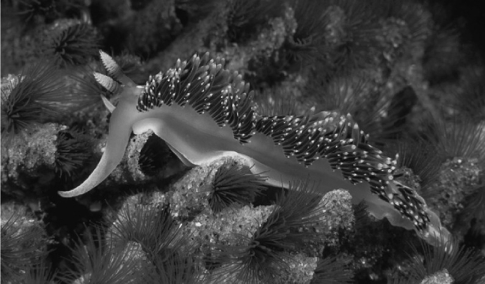
The nematocysts of sea slugs should be most effective at protecting individual sea slugs from predation if the predators ________.
A) remove small bites of flesh from sea slugs and have long-term memory
B) remove small bites of flesh from sea slugs and have no long-term memory
C) consume entire sea slugs in one gulp and have no long-term memory
D) consume entire sea slugs in one gulp and have long-term memory
The nontaxonomic term sea slug encompasses a wide variety of marine gastropods. One feature they share as adults is the lack of a shell. One might think, therefore, that they represent defenseless morsels for predators. In fact, sea slugs have multiple defenses. Some sea slugs prey on sponges and concentrate sponge toxins in their tissues. Others feed on cnidarians, digesting everything except the nematocysts, which they then transfer to their own skins. Whereas the most brightly colored sea slugs are often highly toxic, others are nontoxic and mimic the coloration of the toxic species. Their colors are mostly derived from pigments in their prey. There are also sea slugs that use their coloration to blend into their environments.
This nudibranch, a type of sea slug, has many reddish cerata on its dorsal surface, as well as two white-tipped rhinophores located on the head.

The nematocysts of sea slugs should be most effective at protecting individual sea slugs from predation if the predators ________.
A) remove small bites of flesh from sea slugs and have long-term memory
B) remove small bites of flesh from sea slugs and have no long-term memory
C) consume entire sea slugs in one gulp and have no long-term memory
D) consume entire sea slugs in one gulp and have long-term memory

فتح الحزمة
افتح القفل للوصول البطاقات البالغ عددها 83 في هذه المجموعة.
فتح الحزمة
k this deck
26
Molecular studies have changed many of the phylogenetic relationships previously identified by morphological studies. An example of such a change is ________.
A) Lochotrophozora
B) Placozoa
C) Brachiopoda
D) Bivalvia
A) Lochotrophozora
B) Placozoa
C) Brachiopoda
D) Bivalvia

فتح الحزمة
افتح القفل للوصول البطاقات البالغ عددها 83 في هذه المجموعة.
فتح الحزمة
k this deck
27
Which characteristic is shared by cnidarians and flatworms?
A) dorsoventrally flattened bodies
B) radial symmetry
C) a digestive system with a single opening
D) a distinct head
A) dorsoventrally flattened bodies
B) radial symmetry
C) a digestive system with a single opening
D) a distinct head

فتح الحزمة
افتح القفل للوصول البطاقات البالغ عددها 83 في هذه المجموعة.
فتح الحزمة
k this deck
28
Use the following information to answer the question.
An elementary school science teacher decided to liven up the classroom with a saltwater aquarium. Knowing that saltwater aquaria can be quite a hassle, the teacher proceeded stepwise. First, the teacher conditioned the water. Next, the teacher decided to stock the tank with various marine invertebrates, including a polychaete, a siliceous sponge, several bivalves, a shrimp, several sea anemones of different types, a colonial hydra, a few coral species, an ectoproct, a sea star, and several herbivorous gastropod varieties. Lastly, she added some vertebrates-a parrot fish and a clown fish. She arranged for daily feedings of copepods and feeder fish.
If the teacher wanted to show the students what a lophophore is and how it works, the teacher would point out a feeding ________.
A) hydra
B) sponge
C) gastropod
D) ectoproct
An elementary school science teacher decided to liven up the classroom with a saltwater aquarium. Knowing that saltwater aquaria can be quite a hassle, the teacher proceeded stepwise. First, the teacher conditioned the water. Next, the teacher decided to stock the tank with various marine invertebrates, including a polychaete, a siliceous sponge, several bivalves, a shrimp, several sea anemones of different types, a colonial hydra, a few coral species, an ectoproct, a sea star, and several herbivorous gastropod varieties. Lastly, she added some vertebrates-a parrot fish and a clown fish. She arranged for daily feedings of copepods and feeder fish.
If the teacher wanted to show the students what a lophophore is and how it works, the teacher would point out a feeding ________.
A) hydra
B) sponge
C) gastropod
D) ectoproct

فتح الحزمة
افتح القفل للوصول البطاقات البالغ عددها 83 في هذه المجموعة.
فتح الحزمة
k this deck
29
Against which hard structure do the circular and longitudinal muscles of annelids work?
A) cuticle
B) shell
C) endoskeleton
D) hydrostatic skeleton
A) cuticle
B) shell
C) endoskeleton
D) hydrostatic skeleton

فتح الحزمة
افتح القفل للوصول البطاقات البالغ عددها 83 في هذه المجموعة.
فتح الحزمة
k this deck
30
Which one of these mollusc groups can be classified as suspension feeders?
A) bivalves
B) gastropods
C) chitons
D) cephalopods
A) bivalves
B) gastropods
C) chitons
D) cephalopods

فتح الحزمة
افتح القفل للوصول البطاقات البالغ عددها 83 في هذه المجموعة.
فتح الحزمة
k this deck
31
If a lung were to be found in a mollusc, where would it be located?
A) mantle cavity
B) incurrent siphon
C) visceral mass
D) excurrent siphon
A) mantle cavity
B) incurrent siphon
C) visceral mass
D) excurrent siphon

فتح الحزمة
افتح القفل للوصول البطاقات البالغ عددها 83 في هذه المجموعة.
فتح الحزمة
k this deck
32
Use the information and figure to answer the following question.
The sea slug Pteraeolidia ianthina can harbor living dinoflagellates (photosynthetic protists) in its skin. These endosymbiotic dinoflagellates reproduce quickly enough to maintain their populations. Low populations do not affect the sea slugs very much, but high populations (> 5 × 10⁵ cells/mg of sea slug protein) can promote sea slug survival.
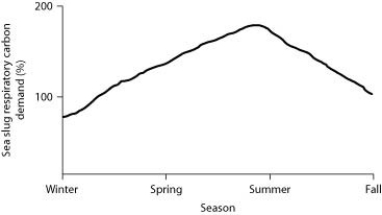
Percent of sea slug respiratory carbon demand provided by indwelling dinoflagellates.
If the dinoflagellate-containing sea slug P. ianthina preys on coral animals, then it would be most surprising to find that ________.
A) P. ianthina can tolerate the toxin in the nematocysts of its prey
B) P. ianthina can locate its coral prey by chemicals released into the water by corals
C) the coral prey harbor dinoflagellates in their tissues
D) the coral prey transform themselves into medusas to flee from approaching P. ianthina
The sea slug Pteraeolidia ianthina can harbor living dinoflagellates (photosynthetic protists) in its skin. These endosymbiotic dinoflagellates reproduce quickly enough to maintain their populations. Low populations do not affect the sea slugs very much, but high populations (> 5 × 10⁵ cells/mg of sea slug protein) can promote sea slug survival.

Percent of sea slug respiratory carbon demand provided by indwelling dinoflagellates.
If the dinoflagellate-containing sea slug P. ianthina preys on coral animals, then it would be most surprising to find that ________.
A) P. ianthina can tolerate the toxin in the nematocysts of its prey
B) P. ianthina can locate its coral prey by chemicals released into the water by corals
C) the coral prey harbor dinoflagellates in their tissues
D) the coral prey transform themselves into medusas to flee from approaching P. ianthina

فتح الحزمة
افتح القفل للوصول البطاقات البالغ عددها 83 في هذه المجموعة.
فتح الحزمة
k this deck
33
Use the information and figure to answer the following question.
The sea slug Pteraeolidia ianthina can harbor living dinoflagellates (photosynthetic protists) in its skin. These endosymbiotic dinoflagellates reproduce quickly enough to maintain their populations. Low populations do not affect the sea slugs very much, but high populations (> 5 × 10⁵ cells/mg of sea slug protein) can promote sea slug survival.
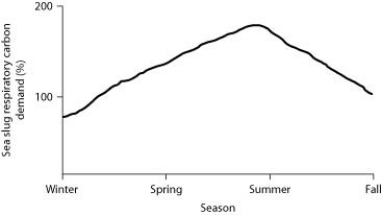
Percent of sea slug respiratory carbon demand provided by indwelling dinoflagellates.
In the graph, the percent of the oxygen demand contributed by the dinoflagellates is greater than 100% during much of the year. What is the fate of this "excess" energy?
A) It is dispersed as "entropy" (disorder in the system).
B) It is saved for producing offspring by the sea slug.
C) It is used to move around the sea bottom.
D) It is used in evaporative cooling by the sea slug.
The sea slug Pteraeolidia ianthina can harbor living dinoflagellates (photosynthetic protists) in its skin. These endosymbiotic dinoflagellates reproduce quickly enough to maintain their populations. Low populations do not affect the sea slugs very much, but high populations (> 5 × 10⁵ cells/mg of sea slug protein) can promote sea slug survival.

Percent of sea slug respiratory carbon demand provided by indwelling dinoflagellates.
In the graph, the percent of the oxygen demand contributed by the dinoflagellates is greater than 100% during much of the year. What is the fate of this "excess" energy?
A) It is dispersed as "entropy" (disorder in the system).
B) It is saved for producing offspring by the sea slug.
C) It is used to move around the sea bottom.
D) It is used in evaporative cooling by the sea slug.

فتح الحزمة
افتح القفل للوصول البطاقات البالغ عددها 83 في هذه المجموعة.
فتح الحزمة
k this deck
34
Use the information and figure to answer the following question.
The sea slug Pteraeolidia ianthina can harbor living dinoflagellates (photosynthetic protists) in its skin. These endosymbiotic dinoflagellates reproduce quickly enough to maintain their populations. Low populations do not affect the sea slugs very much, but high populations (> 5 × 10⁵ cells/mg of sea slug protein) can promote sea slug survival.
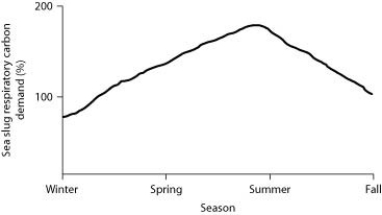
Percent of sea slug respiratory carbon demand provided by indwelling dinoflagellates.
According to the graph, during which season(s) of the year is the relationship between the sea slug and its dinoflagellates closest to being commensal?
A) winter
B) spring
C) summer
D) spring and summer
The sea slug Pteraeolidia ianthina can harbor living dinoflagellates (photosynthetic protists) in its skin. These endosymbiotic dinoflagellates reproduce quickly enough to maintain their populations. Low populations do not affect the sea slugs very much, but high populations (> 5 × 10⁵ cells/mg of sea slug protein) can promote sea slug survival.

Percent of sea slug respiratory carbon demand provided by indwelling dinoflagellates.
According to the graph, during which season(s) of the year is the relationship between the sea slug and its dinoflagellates closest to being commensal?
A) winter
B) spring
C) summer
D) spring and summer

فتح الحزمة
افتح القفل للوصول البطاقات البالغ عددها 83 في هذه المجموعة.
فتح الحزمة
k this deck
35
Use the information to answer the following question.
The nontaxonomic term sea slug encompasses a wide variety of marine gastropods. One feature they share as adults is the lack of a shell. One might think, therefore, that they represent defenseless morsels for predators. In fact, sea slugs have multiple defenses. Some sea slugs prey on sponges and concentrate sponge toxins in their tissues. Others feed on cnidarians, digesting everything except the nematocysts, which they then transfer to their own skins. Whereas the most brightly colored sea slugs are often highly toxic, others are nontoxic and mimic the coloration of the toxic species. Their colors are mostly derived from pigments in their prey. There are also sea slugs that use their coloration to blend into their environments.
This nudibranch, a type of sea slug, has many reddish cerata on its dorsal surface, as well as two white-tipped rhinophores located on the head.
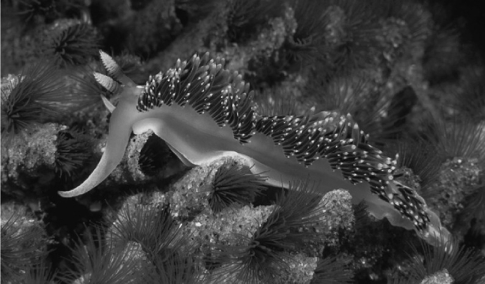
Which structure do sea slugs use to feed on their prey?
A) nematocysts
B) an incurrent siphon
C) a radula
D) a mantle cavity
The nontaxonomic term sea slug encompasses a wide variety of marine gastropods. One feature they share as adults is the lack of a shell. One might think, therefore, that they represent defenseless morsels for predators. In fact, sea slugs have multiple defenses. Some sea slugs prey on sponges and concentrate sponge toxins in their tissues. Others feed on cnidarians, digesting everything except the nematocysts, which they then transfer to their own skins. Whereas the most brightly colored sea slugs are often highly toxic, others are nontoxic and mimic the coloration of the toxic species. Their colors are mostly derived from pigments in their prey. There are also sea slugs that use their coloration to blend into their environments.
This nudibranch, a type of sea slug, has many reddish cerata on its dorsal surface, as well as two white-tipped rhinophores located on the head.

Which structure do sea slugs use to feed on their prey?
A) nematocysts
B) an incurrent siphon
C) a radula
D) a mantle cavity

فتح الحزمة
افتح القفل للوصول البطاقات البالغ عددها 83 في هذه المجموعة.
فتح الحزمة
k this deck
36
Planarians lack dedicated respiratory and circulatory systems. This deficiency does not cause a problem because ________.
A) none of their cells are far removed from the gastrovascular cavity or from the external environment
B) they lack mesoderm as embryos and, therefore, lack the adult tissues derived from mesoderm
C) their flame bulbs can carry out respiratory and circulatory functions
D) their body cavity, a pseudocoelom, carries out these functions
A) none of their cells are far removed from the gastrovascular cavity or from the external environment
B) they lack mesoderm as embryos and, therefore, lack the adult tissues derived from mesoderm
C) their flame bulbs can carry out respiratory and circulatory functions
D) their body cavity, a pseudocoelom, carries out these functions

فتح الحزمة
افتح القفل للوصول البطاقات البالغ عددها 83 في هذه المجموعة.
فتح الحزمة
k this deck
37
Use the information to answer the following question.
The nontaxonomic term sea slug encompasses a wide variety of marine gastropods. One feature they share as adults is the lack of a shell. One might think, therefore, that they represent defenseless morsels for predators. In fact, sea slugs have multiple defenses. Some sea slugs prey on sponges and concentrate sponge toxins in their tissues. Others feed on cnidarians, digesting everything except the nematocysts, which they then transfer to their own skins. Whereas the most brightly colored sea slugs are often highly toxic, others are nontoxic and mimic the coloration of the toxic species. Their colors are mostly derived from pigments in their prey. There are also sea slugs that use their coloration to blend into their environments.
This nudibranch, a type of sea slug, has many reddish cerata on its dorsal surface, as well as two white-tipped rhinophores located on the head.

The nematocysts most likely reach the skin of sea slugs through branches of the ________.
A) intestine
B) excurrent siphon
C) nephridium
D) pseudocoelom
The nontaxonomic term sea slug encompasses a wide variety of marine gastropods. One feature they share as adults is the lack of a shell. One might think, therefore, that they represent defenseless morsels for predators. In fact, sea slugs have multiple defenses. Some sea slugs prey on sponges and concentrate sponge toxins in their tissues. Others feed on cnidarians, digesting everything except the nematocysts, which they then transfer to their own skins. Whereas the most brightly colored sea slugs are often highly toxic, others are nontoxic and mimic the coloration of the toxic species. Their colors are mostly derived from pigments in their prey. There are also sea slugs that use their coloration to blend into their environments.
This nudibranch, a type of sea slug, has many reddish cerata on its dorsal surface, as well as two white-tipped rhinophores located on the head.

The nematocysts most likely reach the skin of sea slugs through branches of the ________.
A) intestine
B) excurrent siphon
C) nephridium
D) pseudocoelom

فتح الحزمة
افتح القفل للوصول البطاقات البالغ عددها 83 في هذه المجموعة.
فتح الحزمة
k this deck
38
Which of the following organisms would you expect to have the largest surface-area-to-volume ratio? Assume that all of the following are the same total length.
A) a mollusc
B) an annelid
C) an arthropod
D) a platyhelminth
A) a mollusc
B) an annelid
C) an arthropod
D) a platyhelminth

فتح الحزمة
افتح القفل للوصول البطاقات البالغ عددها 83 في هذه المجموعة.
فتح الحزمة
k this deck
39
Large animals need specialized organs for gas exchange because ________.
A) they require more oxygen per unit of volume
B) surface area increases more rapidly than volume as size increases
C) volume increases more rapidly than surface area as size increases
D) they collect more energy and therefore have more energy to allocate to specialized tissues
A) they require more oxygen per unit of volume
B) surface area increases more rapidly than volume as size increases
C) volume increases more rapidly than surface area as size increases
D) they collect more energy and therefore have more energy to allocate to specialized tissues

فتح الحزمة
افتح القفل للوصول البطاقات البالغ عددها 83 في هذه المجموعة.
فتح الحزمة
k this deck
40
The sea slug Elysia chorotica has no nematocysts or dinoflagellates but, rather, has "naked" chloroplasts in its skin. The chloroplasts are all that remain of the seaweed (Vaucheria sp.) that Elysia feeds upon. The chloroplasts are transferred to the skin; consequently, this slug is green. It spends most of its time basking in shallow water on the surface of seaweeds. How should we expect its chloroplasts to benefit the Elysia sea slug?
A) provide Elysia with fixed nitrogen
B) provide Elysia with fixed carbon dioxide
C) provide Elysia with fixed oxygen
D) provide Elysia with a bright color that warns away potential predators
A) provide Elysia with fixed nitrogen
B) provide Elysia with fixed carbon dioxide
C) provide Elysia with fixed oxygen
D) provide Elysia with a bright color that warns away potential predators

فتح الحزمة
افتح القفل للوصول البطاقات البالغ عددها 83 في هذه المجموعة.
فتح الحزمة
k this deck
41
Which of the following changes would lead to an increase in surface-area-to-volume ratios?
A) thickening of the body of earthworms
B) increasing the number of layers in the chloroplasts of plants
C) decreasing the projections of the choanocytes of sponges on the outer surface of the body
D) reducing the branching of the mesoderm tissues of sponges
A) thickening of the body of earthworms
B) increasing the number of layers in the chloroplasts of plants
C) decreasing the projections of the choanocytes of sponges on the outer surface of the body
D) reducing the branching of the mesoderm tissues of sponges

فتح الحزمة
افتح القفل للوصول البطاقات البالغ عددها 83 في هذه المجموعة.
فتح الحزمة
k this deck
42
Nematodes and arthropods both ________.
A) develop an anus from the blastopore (pore) formed in the gastrula stage
B) are parasites
C) grow in conjunction with shedding of their exoskeleton
D) have ciliated larvae
A) develop an anus from the blastopore (pore) formed in the gastrula stage
B) are parasites
C) grow in conjunction with shedding of their exoskeleton
D) have ciliated larvae

فتح الحزمة
افتح القفل للوصول البطاقات البالغ عددها 83 في هذه المجموعة.
فتح الحزمة
k this deck
43
In a tide pool, a student encounters an organism with a hard outer covering that contains much calcium carbonate, an open circulatory system, and gills. The organism could potentially be a crab, a shrimp, a barnacle, or a bivalve. The presence of which of the following structures would allow for the most certain identification of the organism?
A) a mantle
B) a heart
C) a body cavity
D) a filter-feeding apparatus
A) a mantle
B) a heart
C) a body cavity
D) a filter-feeding apparatus

فتح الحزمة
افتح القفل للوصول البطاقات البالغ عددها 83 في هذه المجموعة.
فتح الحزمة
k this deck
44
Toilets are a modern convenience that people often take for granted. In fact, they are helpful in preventing spread of disease because ________.
A) disease-causing insects die quickly in fecal-contaminated water
B) toilets disinfect human feces
C) many diseases are transmitted by flying insects
D) many parasites release fertilized eggs in the feces of humans and other animals
A) disease-causing insects die quickly in fecal-contaminated water
B) toilets disinfect human feces
C) many diseases are transmitted by flying insects
D) many parasites release fertilized eggs in the feces of humans and other animals

فتح الحزمة
افتح القفل للوصول البطاقات البالغ عددها 83 في هذه المجموعة.
فتح الحزمة
k this deck
45
Imagine that you are a research chemist who wishes to develop a chemical adhesive that will work under water. Which of the following organisms might give you a clue about where to start?
A) sea wasps
B) trematodes
C) lobsters
D) mussels
A) sea wasps
B) trematodes
C) lobsters
D) mussels

فتح الحزمة
افتح القفل للوصول البطاقات البالغ عددها 83 في هذه المجموعة.
فتح الحزمة
k this deck
46
All insects ________.
A) undergo complete metamorphosis and have segmented bodies
B) have jointed appendages and a radula
C) undergo complete metamorphosis and have an exoskeleton or cuticle
D) have jointed appendages and spicules
A) undergo complete metamorphosis and have segmented bodies
B) have jointed appendages and a radula
C) undergo complete metamorphosis and have an exoskeleton or cuticle
D) have jointed appendages and spicules

فتح الحزمة
افتح القفل للوصول البطاقات البالغ عددها 83 في هذه المجموعة.
فتح الحزمة
k this deck
47
Whiteflies are common pest insects found on cotton, tomato, poinsettia, and many other plants. Nymphs are translucent and mostly sessile, feeding on their host plant's phloem (sap) from the undersides of leaves. They undergo incomplete metamorphosis into winged adults. Because whitefly nymphs cannot escape predation by moving, you hypothesize that their translucent bodies make them hard to spot by predators. How could you directly test this hypothesis?
A) Compare rates of predation on whitefly nymphs on plant leaves of different colors (for example, red versus green poinsettia leaves).
B) Compare rates of predation on whitefly nymphs coated with a nontoxic dye versus undyed whitefly nymphs.
C) Compare rates of predation on whitefly nymphs versus whitefly adults.
D) Compare rates of predation on whitefly nymphs by predators that are translucent versus predators that are not translucent.
A) Compare rates of predation on whitefly nymphs on plant leaves of different colors (for example, red versus green poinsettia leaves).
B) Compare rates of predation on whitefly nymphs coated with a nontoxic dye versus undyed whitefly nymphs.
C) Compare rates of predation on whitefly nymphs versus whitefly adults.
D) Compare rates of predation on whitefly nymphs by predators that are translucent versus predators that are not translucent.

فتح الحزمة
افتح القفل للوصول البطاقات البالغ عددها 83 في هذه المجموعة.
فتح الحزمة
k this deck
48
Use the following information and figures to answer the question.
Many terrestrial arthropods exchange gases with their environments by using tracheae, tubes that lead from openings (called spiracles) in the animal's exoskeleton or cuticle directly to the animal's tissues. Some arthropods can control whether their spiracles are opened or closed; opening the spiracles allows the carbon dioxide produced in the tissues to travel down the tracheae and be released outside the animal. Klok et al. measured the carbon dioxide emitted over time (represented by ⱽCO₂) by several species of centipedes. The figures present graphs of their results for two species, Cormocephalus morsitans and Scutigerina weberi.

Look at the graph for Scutigerina weberi (note the scale of the y-axis) in the figure. What is the best interpretation of these results?
A) The centipede had its spiracles open the entire time.
B) The centipede had its spiracles closed the entire time.
C) The centipede had its spiracles open when carbon dioxide (CO₂) emission peaked and closed when CO₂ emission was low.
D) The centipede had its spiracles closed when carbon dioxide (CO₂) emission peaked and open when CO₂ emission was low.
Many terrestrial arthropods exchange gases with their environments by using tracheae, tubes that lead from openings (called spiracles) in the animal's exoskeleton or cuticle directly to the animal's tissues. Some arthropods can control whether their spiracles are opened or closed; opening the spiracles allows the carbon dioxide produced in the tissues to travel down the tracheae and be released outside the animal. Klok et al. measured the carbon dioxide emitted over time (represented by ⱽCO₂) by several species of centipedes. The figures present graphs of their results for two species, Cormocephalus morsitans and Scutigerina weberi.

Look at the graph for Scutigerina weberi (note the scale of the y-axis) in the figure. What is the best interpretation of these results?
A) The centipede had its spiracles open the entire time.
B) The centipede had its spiracles closed the entire time.
C) The centipede had its spiracles open when carbon dioxide (CO₂) emission peaked and closed when CO₂ emission was low.
D) The centipede had its spiracles closed when carbon dioxide (CO₂) emission peaked and open when CO₂ emission was low.

فتح الحزمة
افتح القفل للوصول البطاقات البالغ عددها 83 في هذه المجموعة.
فتح الحزمة
k this deck
49
Use the following information to answer the question.
Nudibranchs, a type of predatory sea slug, can have various protuberances (that is, extensions) on their dorsal surfaces. Rhinophores are paired structures, located close to the head, which bear many chemoreceptors. Dorsal plumules, usually located posteriorly, perform respiratory gas exchange. Cerata usually cover much of the dorsal surface and contain nematocysts at their tips.
The claws on the foremost trunk segment of centipedes have a function most similar to that of ________.
A) rhinophores
B) dorsal plumules
C) cerata
D) chemoreceptors
Nudibranchs, a type of predatory sea slug, can have various protuberances (that is, extensions) on their dorsal surfaces. Rhinophores are paired structures, located close to the head, which bear many chemoreceptors. Dorsal plumules, usually located posteriorly, perform respiratory gas exchange. Cerata usually cover much of the dorsal surface and contain nematocysts at their tips.
The claws on the foremost trunk segment of centipedes have a function most similar to that of ________.
A) rhinophores
B) dorsal plumules
C) cerata
D) chemoreceptors

فتح الحزمة
افتح القفل للوصول البطاقات البالغ عددها 83 في هذه المجموعة.
فتح الحزمة
k this deck
50
Use the following information and figures to answer the question.
Many terrestrial arthropods exchange gases with their environments by using tracheae, tubes that lead from openings (called spiracles) in the animal's exoskeleton or cuticle directly to the animal's tissues. Some arthropods can control whether their spiracles are opened or closed; opening the spiracles allows the carbon dioxide produced in the tissues to travel down the tracheae and be released outside the animal. Klok et al. measured the carbon dioxide emitted over time (represented by ⱽCO₂) by several species of centipedes. The figures present graphs of their results for two species, Cormocephalus morsitans and Scutigerina weberi.
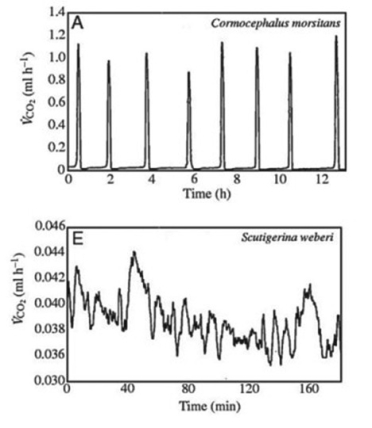
Look at the graph for Cormocephalus morsitans in the figure. What is the best interpretation of these results?
A) The centipede had its spiracles open the entire time.
B) The centipede had its spiracles closed the entire time.
C) The centipede had its spiracles open when carbon dioxide (CO₂) emission peaked and closed when CO₂ emission was low.
D) The centipede had its spiracles closed when carbon dioxide (CO₂) emission peaked and open when CO₂ emission was low.
Many terrestrial arthropods exchange gases with their environments by using tracheae, tubes that lead from openings (called spiracles) in the animal's exoskeleton or cuticle directly to the animal's tissues. Some arthropods can control whether their spiracles are opened or closed; opening the spiracles allows the carbon dioxide produced in the tissues to travel down the tracheae and be released outside the animal. Klok et al. measured the carbon dioxide emitted over time (represented by ⱽCO₂) by several species of centipedes. The figures present graphs of their results for two species, Cormocephalus morsitans and Scutigerina weberi.

Look at the graph for Cormocephalus morsitans in the figure. What is the best interpretation of these results?
A) The centipede had its spiracles open the entire time.
B) The centipede had its spiracles closed the entire time.
C) The centipede had its spiracles open when carbon dioxide (CO₂) emission peaked and closed when CO₂ emission was low.
D) The centipede had its spiracles closed when carbon dioxide (CO₂) emission peaked and open when CO₂ emission was low.

فتح الحزمة
افتح القفل للوصول البطاقات البالغ عددها 83 في هذه المجموعة.
فتح الحزمة
k this deck
51
Use the following information and figures to answer the question.
Many terrestrial arthropods exchange gases with their environments by using tracheae, tubes that lead from openings (called spiracles) in the animal's exoskeleton or cuticle directly to the animal's tissues. Some arthropods can control whether their spiracles are opened or closed; opening the spiracles allows the carbon dioxide produced in the tissues to travel down the tracheae and be released outside the animal. Klok et al. measured the carbon dioxide emitted over time (represented by ⱽCO₂) by several species of centipedes. The figures present graphs of their results for two species, Cormocephalus morsitans and Scutigerina weberi.
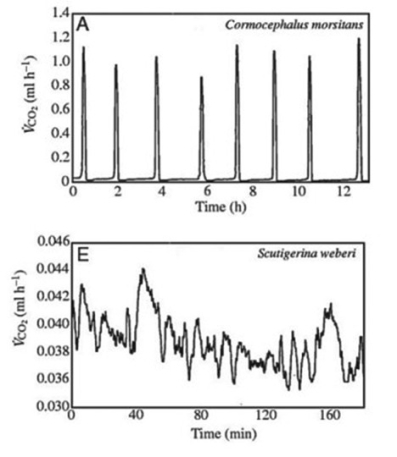
Compare the graphs in the figure of carbon dioxide (CO₂) emission for Cormocephalus morsitans and Scutigerina weberi. What hypothesis can you make about each centipede's habitat?
A) C. morsitans lives in a habitat that provides more carbon dioxide than does S. weberi.
B) C. morsitans lives in a habitat with more predators than does S. weberi.
C) C. morsitans lives in a colder habitat than does S. weberi.
D) C. morsitans lives in a drier habitat than does S. weberi.
Many terrestrial arthropods exchange gases with their environments by using tracheae, tubes that lead from openings (called spiracles) in the animal's exoskeleton or cuticle directly to the animal's tissues. Some arthropods can control whether their spiracles are opened or closed; opening the spiracles allows the carbon dioxide produced in the tissues to travel down the tracheae and be released outside the animal. Klok et al. measured the carbon dioxide emitted over time (represented by ⱽCO₂) by several species of centipedes. The figures present graphs of their results for two species, Cormocephalus morsitans and Scutigerina weberi.

Compare the graphs in the figure of carbon dioxide (CO₂) emission for Cormocephalus morsitans and Scutigerina weberi. What hypothesis can you make about each centipede's habitat?
A) C. morsitans lives in a habitat that provides more carbon dioxide than does S. weberi.
B) C. morsitans lives in a habitat with more predators than does S. weberi.
C) C. morsitans lives in a colder habitat than does S. weberi.
D) C. morsitans lives in a drier habitat than does S. weberi.

فتح الحزمة
افتح القفل للوصول البطاقات البالغ عددها 83 في هذه المجموعة.
فتح الحزمة
k this deck
52
Arthropod exoskeletons and mollusc shells both ________.
A) completely replace the hydrostatic skeleton
B) are secreted by the mantle
C) help retain moisture in terrestrial habitats
D) are comprised of the polysaccharide chitin
A) completely replace the hydrostatic skeleton
B) are secreted by the mantle
C) help retain moisture in terrestrial habitats
D) are comprised of the polysaccharide chitin

فتح الحزمة
افتح القفل للوصول البطاقات البالغ عددها 83 في هذه المجموعة.
فتح الحزمة
k this deck
53
Use the following information and figures to answer the question.
Many terrestrial arthropods exchange gases with their environments by using tracheae, tubes that lead from openings (called spiracles) in the animal's exoskeleton or cuticle directly to the animal's tissues. Some arthropods can control whether their spiracles are opened or closed; opening the spiracles allows the carbon dioxide produced in the tissues to travel down the tracheae and be released outside the animal. Klok et al. measured the carbon dioxide emitted over time (represented by ⱽCO₂) by several species of centipedes. The figures present graphs of their results for two species, Cormocephalus morsitans and Scutigerina weberi.
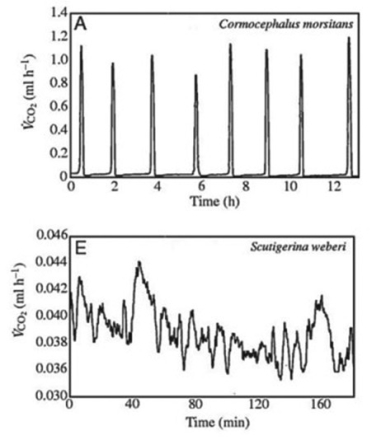
How would a terrestrial centipede most likely benefit from the ability to close its spiracles? Closing spiracles would ________.
A) allow the centipede to move more quickly
B) allow the centipede to retain more moisture in its tissues
C) allow the centipede to stay warmer
D) allow more oxygen from the environment to reach the centipede's tissues
Many terrestrial arthropods exchange gases with their environments by using tracheae, tubes that lead from openings (called spiracles) in the animal's exoskeleton or cuticle directly to the animal's tissues. Some arthropods can control whether their spiracles are opened or closed; opening the spiracles allows the carbon dioxide produced in the tissues to travel down the tracheae and be released outside the animal. Klok et al. measured the carbon dioxide emitted over time (represented by ⱽCO₂) by several species of centipedes. The figures present graphs of their results for two species, Cormocephalus morsitans and Scutigerina weberi.

How would a terrestrial centipede most likely benefit from the ability to close its spiracles? Closing spiracles would ________.
A) allow the centipede to move more quickly
B) allow the centipede to retain more moisture in its tissues
C) allow the centipede to stay warmer
D) allow more oxygen from the environment to reach the centipede's tissues

فتح الحزمة
افتح القفل للوصول البطاقات البالغ عددها 83 في هذه المجموعة.
فتح الحزمة
k this deck
54
The heartworms that can accumulate within the hearts of dogs and other mammals have a pseudocoelom, an alimentary canal, and an outer covering that is occasionally shed. To which phylum does the heartworm belong?
A) Platyhelminthes
B) Arthropoda
C) Nematoda
D) Annelida
A) Platyhelminthes
B) Arthropoda
C) Nematoda
D) Annelida

فتح الحزمة
افتح القفل للوصول البطاقات البالغ عددها 83 في هذه المجموعة.
فتح الحزمة
k this deck
55
You find a multi-legged animal in your garden and want to determine if it is a centipede or a millipede. You take the animal to a university where a myriapodologist quickly tells you that you have found a centipede. Which of the following traits may have allowed her to make this distinction?
A) presence of body segments
B) poisonous claws
C) egg-laying
D) molting
A) presence of body segments
B) poisonous claws
C) egg-laying
D) molting

فتح الحزمة
افتح القفل للوصول البطاقات البالغ عددها 83 في هذه المجموعة.
فتح الحزمة
k this deck
56
Imagine that you are a graduate student seeking an idea for a research project that will help us understand the evolution of a parasitic lifestyle from a free-living lifestyle. Which of the following outcomes would you expect if you compare the genes of parasitic species to relatives that are free living?
A) The parasitic species will have fewer functioning genes than the free-living species because loss of many genes will not be harmful.
B) The free-living species will have more functioning genes because they evolved new traits.
C) The genes will have changed in base sequence, but the number of functioning genes in parasitic and free-living species will be the same.
D) More genes for sensing the environment will have evolved in the parasitic species as compared to the free-living species.
A) The parasitic species will have fewer functioning genes than the free-living species because loss of many genes will not be harmful.
B) The free-living species will have more functioning genes because they evolved new traits.
C) The genes will have changed in base sequence, but the number of functioning genes in parasitic and free-living species will be the same.
D) More genes for sensing the environment will have evolved in the parasitic species as compared to the free-living species.

فتح الحزمة
افتح القفل للوصول البطاقات البالغ عددها 83 في هذه المجموعة.
فتح الحزمة
k this deck
57
Without genetic variation, evolution cannot occur. Sexual reproduction leads to increased genetic variation, but male bdelloid rotifers have never been observed. Which of the following are correct statements with regard to evolution in bdelloid rotifers?
A) As we learn more about bdelloid rotifers, we find males in more and more species.
B) Bdelloid rotifers gain genetic variation by absorbing DNA from the external environment.
C) Protists infect bdelloids and bring DNA from other rotifers with them.
D) Bdelloid rotifers have lost the ability to reproduce sexually only recently.
A) As we learn more about bdelloid rotifers, we find males in more and more species.
B) Bdelloid rotifers gain genetic variation by absorbing DNA from the external environment.
C) Protists infect bdelloids and bring DNA from other rotifers with them.
D) Bdelloid rotifers have lost the ability to reproduce sexually only recently.

فتح الحزمة
افتح القفل للوصول البطاقات البالغ عددها 83 في هذه المجموعة.
فتح الحزمة
k this deck
58
A terrestrial animal species is discovered with the following larval characteristics: exoskeleton, system of tubes for gas exchange, and modified segmentation. A knowledgeable zoologist should predict that the adults of this species would also feature ________.
A) eight legs
B) two pairs of antennae
C) a sessile lifestyle
D) an open circulatory system
A) eight legs
B) two pairs of antennae
C) a sessile lifestyle
D) an open circulatory system

فتح الحزمة
افتح القفل للوصول البطاقات البالغ عددها 83 في هذه المجموعة.
فتح الحزمة
k this deck
59
Which of the following statements about bryozoans (ectoprocts) is correct?
A) Bryozoans are colonial, build reefs, and are related to corals.
B) Bryozoans are colonial and live amongst mosses.
C) Adult bryozoans are sessile, but their larvae make up much of marine plankton.
D) Bryozoans build reefs and have lophophores that extend through a hard exoskeleton.
A) Bryozoans are colonial, build reefs, and are related to corals.
B) Bryozoans are colonial and live amongst mosses.
C) Adult bryozoans are sessile, but their larvae make up much of marine plankton.
D) Bryozoans build reefs and have lophophores that extend through a hard exoskeleton.

فتح الحزمة
افتح القفل للوصول البطاقات البالغ عددها 83 في هذه المجموعة.
فتح الحزمة
k this deck
60
What would be the most direct effect of removing or damaging an insect's antennae? The insect would have trouble ________.
A) hearing
B) mating
C) seeing
D) smelling
A) hearing
B) mating
C) seeing
D) smelling

فتح الحزمة
افتح القفل للوصول البطاقات البالغ عددها 83 في هذه المجموعة.
فتح الحزمة
k this deck
61
Use the following information to answer the question.
Nudibranchs, a type of predatory sea slug, can have various protuberances (that is, extensions) on their dorsal surfaces. Rhinophores are paired structures, located close to the head, which bear many chemoreceptors. Dorsal plumules, usually located posteriorly, perform respiratory gas exchange. Cerata usually cover much of the dorsal surface and contain nematocysts at their tips.
The spiracles and tracheae of insects have a function most similar to that of ________.
A) rhinophores
B) dorsal plumules
C) cerata
D) chemoreceptors
Nudibranchs, a type of predatory sea slug, can have various protuberances (that is, extensions) on their dorsal surfaces. Rhinophores are paired structures, located close to the head, which bear many chemoreceptors. Dorsal plumules, usually located posteriorly, perform respiratory gas exchange. Cerata usually cover much of the dorsal surface and contain nematocysts at their tips.
The spiracles and tracheae of insects have a function most similar to that of ________.
A) rhinophores
B) dorsal plumules
C) cerata
D) chemoreceptors

فتح الحزمة
افتح القفل للوصول البطاقات البالغ عددها 83 في هذه المجموعة.
فتح الحزمة
k this deck
62
Use the following information to answer the question.
A farm pond, usually dry during winter, has plenty of water and aquatic pond life during the summer. One summer, Sarah returns to the family farm from college. Observing the pond, she is fascinated by some six-legged organisms that can crawl about on submerged surfaces or, when disturbed, seemingly "jet" through the water. Watching further, she is able to conclude that the "mystery organisms" are ambush predators, and their prey includes everything from insects to small fish and tadpoles.
If the pond organisms are larvae, rather than adults, Sarah should expect them to have all of the following structures, except ________.
A) antennae
B) an open circulatory system
C) an exoskeleton of chitin
D) sex organs
A farm pond, usually dry during winter, has plenty of water and aquatic pond life during the summer. One summer, Sarah returns to the family farm from college. Observing the pond, she is fascinated by some six-legged organisms that can crawl about on submerged surfaces or, when disturbed, seemingly "jet" through the water. Watching further, she is able to conclude that the "mystery organisms" are ambush predators, and their prey includes everything from insects to small fish and tadpoles.
If the pond organisms are larvae, rather than adults, Sarah should expect them to have all of the following structures, except ________.
A) antennae
B) an open circulatory system
C) an exoskeleton of chitin
D) sex organs

فتح الحزمة
افتح القفل للوصول البطاقات البالغ عددها 83 في هذه المجموعة.
فتح الحزمة
k this deck
63
Echinoderms show enormous diversity in which of the following traits?
A) body shape and food habits
B) food habits and body symmetry
C) body symmetry and method of food digestion
D) method of food digestion and body shape
A) body shape and food habits
B) food habits and body symmetry
C) body symmetry and method of food digestion
D) method of food digestion and body shape

فتح الحزمة
افتح القفل للوصول البطاقات البالغ عددها 83 في هذه المجموعة.
فتح الحزمة
k this deck
64
Which of the following statements is correct with respect to the evolutionary relationship between chordates and invertebrates?
A) Chordates are most closely related to arthropods.
B) Chordates evolved from echinoderms.
C) Chordates are more closely related to echinoderms than to arthropods.
D) Chordates are most closely related to the tunicate-type of echinoderms.
A) Chordates are most closely related to arthropods.
B) Chordates evolved from echinoderms.
C) Chordates are more closely related to echinoderms than to arthropods.
D) Chordates are most closely related to the tunicate-type of echinoderms.

فتح الحزمة
افتح القفل للوصول البطاقات البالغ عددها 83 في هذه المجموعة.
فتح الحزمة
k this deck
65
Use the following information to answer the question.
An elementary school science teacher decided to liven up the classroom with a saltwater aquarium. Knowing that saltwater aquaria can be quite a hassle, the teacher proceeded stepwise. First, the teacher conditioned the water. Next, the teacher decided to stock the tank with various marine invertebrates, including a polychaete, a siliceous sponge, several bivalves, a shrimp, several sea anemones of different types, a colonial hydra, a few coral species, an ectoproct, a sea star, and several herbivorous gastropod varieties. Lastly, she added some vertebrates-a parrot fish and a clown fish. She arranged for daily feedings of copepods and feeder fish.
The bivalves started to die one by one; only the undamaged shells remained. To keep the remaining bivalves alive, the teacher would most likely need to remove the ________.
A) sea anemones
B) sea star
C) gastropods
D) ectoprocts
An elementary school science teacher decided to liven up the classroom with a saltwater aquarium. Knowing that saltwater aquaria can be quite a hassle, the teacher proceeded stepwise. First, the teacher conditioned the water. Next, the teacher decided to stock the tank with various marine invertebrates, including a polychaete, a siliceous sponge, several bivalves, a shrimp, several sea anemones of different types, a colonial hydra, a few coral species, an ectoproct, a sea star, and several herbivorous gastropod varieties. Lastly, she added some vertebrates-a parrot fish and a clown fish. She arranged for daily feedings of copepods and feeder fish.
The bivalves started to die one by one; only the undamaged shells remained. To keep the remaining bivalves alive, the teacher would most likely need to remove the ________.
A) sea anemones
B) sea star
C) gastropods
D) ectoprocts

فتح الحزمة
افتح القفل للوصول البطاقات البالغ عددها 83 في هذه المجموعة.
فتح الحزمة
k this deck
66
Compared to insects with incomplete metamorphosis, insects with complete metamorphosis ________.
A) grow more slowly in size
B) use a greater variety of food resources
C) have slower population growth rates
D) have better abilities to escape from predators
A) grow more slowly in size
B) use a greater variety of food resources
C) have slower population growth rates
D) have better abilities to escape from predators

فتح الحزمة
افتح القفل للوصول البطاقات البالغ عددها 83 في هذه المجموعة.
فتح الحزمة
k this deck
67
A land snail, a clam, and an octopus all share
A) a mantle.
B) a radula.
C) gills.
D) distinct cephalization.
A) a mantle.
B) a radula.
C) gills.
D) distinct cephalization.

فتح الحزمة
افتح القفل للوصول البطاقات البالغ عددها 83 في هذه المجموعة.
فتح الحزمة
k this deck
68
As you are walking along a beach, you find an animal and believe that it belongs to the class Asteroidea. Which of the following characteristics would support your hypothesis that the animal is a sea star and not another type of echinoderm?
A) It is pentaradially symmetric.
B) It feeds on other animals.
C) It has a hydrostatic skeleton, formed from its water vascular system.
D) Its central region is not well delineated from its appendages.
A) It is pentaradially symmetric.
B) It feeds on other animals.
C) It has a hydrostatic skeleton, formed from its water vascular system.
D) Its central region is not well delineated from its appendages.

فتح الحزمة
افتح القفل للوصول البطاقات البالغ عددها 83 في هذه المجموعة.
فتح الحزمة
k this deck
69
Which phylum is characterized by animals that have a segmented body?
A) Cnidaria
B) Platyhelminthes
C) Arthropoda
D) Mollusca
A) Cnidaria
B) Platyhelminthes
C) Arthropoda
D) Mollusca

فتح الحزمة
افتح القفل للوصول البطاقات البالغ عددها 83 في هذه المجموعة.
فتح الحزمة
k this deck
70
Use the following information to answer the question.
A farm pond, usually dry during winter, has plenty of water and aquatic pond life during the summer. One summer, Sarah returns to the family farm from college. Observing the pond, she is fascinated by some six-legged organisms that can crawl about on submerged surfaces or, when disturbed, seemingly "jet" through the water. Watching further, she is able to conclude that the "mystery organisms" are ambush predators, and their prey includes everything from insects to small fish and tadpoles.
Sarah observed that the mystery pond organisms never come up to the pond's surface. If she catches one of these organisms and observes closely, perhaps dissecting the organism, she should find ________.
A) gills
B) spiracles
C) tracheae
D) book lungs
A farm pond, usually dry during winter, has plenty of water and aquatic pond life during the summer. One summer, Sarah returns to the family farm from college. Observing the pond, she is fascinated by some six-legged organisms that can crawl about on submerged surfaces or, when disturbed, seemingly "jet" through the water. Watching further, she is able to conclude that the "mystery organisms" are ambush predators, and their prey includes everything from insects to small fish and tadpoles.
Sarah observed that the mystery pond organisms never come up to the pond's surface. If she catches one of these organisms and observes closely, perhaps dissecting the organism, she should find ________.
A) gills
B) spiracles
C) tracheae
D) book lungs

فتح الحزمة
افتح القفل للوصول البطاقات البالغ عددها 83 في هذه المجموعة.
فتح الحزمة
k this deck
71
The water vascular system of echinoderms ________.
A) functions as a circulatory system that distributes nutrients to body cells
B) functions in locomotion and feeding
C) is bilateral in organization, even though the adult animal is not bilaterally symmetrical
D) is analogous to the gastrovascular cavity of flatworms
A) functions as a circulatory system that distributes nutrients to body cells
B) functions in locomotion and feeding
C) is bilateral in organization, even though the adult animal is not bilaterally symmetrical
D) is analogous to the gastrovascular cavity of flatworms

فتح الحزمة
افتح القفل للوصول البطاقات البالغ عددها 83 في هذه المجموعة.
فتح الحزمة
k this deck
72
Use the following information and figure to answer the question.
Aphids are Hemiptera that suck phloem liquid from plants. Ants are often seen tapping the posterior end of the aphid and collecting the liquid that is released from the aphid's digestive system. In an effort to understand this interaction, several researchers measure the survival rates of aphid populations when ants were present and when they were excluded. Their results are shown.
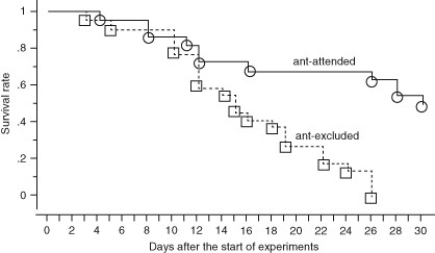
Imagine that you wished to discover if the ants protect the aphids from flying predators. You would exclude ants from the plants and count aphid population size under two conditions. Which of the following experiments would best help answer this question?
A) plants covered by netting versus not covered by netting
B) plants with stems coated at the base with a sticky substance versus not coated with a sticky substance
C) plants with extra fertilizer and water versus no extra fertilizer and water
D) plants sprayed with insecticide versus not sprayed with insecticide
Aphids are Hemiptera that suck phloem liquid from plants. Ants are often seen tapping the posterior end of the aphid and collecting the liquid that is released from the aphid's digestive system. In an effort to understand this interaction, several researchers measure the survival rates of aphid populations when ants were present and when they were excluded. Their results are shown.

Imagine that you wished to discover if the ants protect the aphids from flying predators. You would exclude ants from the plants and count aphid population size under two conditions. Which of the following experiments would best help answer this question?
A) plants covered by netting versus not covered by netting
B) plants with stems coated at the base with a sticky substance versus not coated with a sticky substance
C) plants with extra fertilizer and water versus no extra fertilizer and water
D) plants sprayed with insecticide versus not sprayed with insecticide

فتح الحزمة
افتح القفل للوصول البطاقات البالغ عددها 83 في هذه المجموعة.
فتح الحزمة
k this deck
73
Soft-shell crab is a prized dish in many ocean-side resorts. Why are the crabs' shells soft?
A) The crab has just molted and the new exoskeleton has not yet hardened.
B) These species of crabs live under rocks and therefore have lost the hard exoskeleton over evolutionary time.
C) These species have evolved a light and soft exoskeleton so that gases can diffuse directly between body of the crab and the surrounding water.
D) These species have evolved a light and soft exoskeleton so that they can float in the water column.
A) The crab has just molted and the new exoskeleton has not yet hardened.
B) These species of crabs live under rocks and therefore have lost the hard exoskeleton over evolutionary time.
C) These species have evolved a light and soft exoskeleton so that gases can diffuse directly between body of the crab and the surrounding water.
D) These species have evolved a light and soft exoskeleton so that they can float in the water column.

فتح الحزمة
افتح القفل للوصول البطاقات البالغ عددها 83 في هذه المجموعة.
فتح الحزمة
k this deck
74
Which of the following combinations correctly matches a phylum to its description?
A) Echinodermata-bilateral symmetry as a larva, water vascular system
B) Nematoda-segmented worms, closed circulatory system
C) Cnidaria-flatworms, gastrovascular cavity, acoelomate
D) Platyhelminthes-radial symmetry, polyp and medusa body forms
A) Echinodermata-bilateral symmetry as a larva, water vascular system
B) Nematoda-segmented worms, closed circulatory system
C) Cnidaria-flatworms, gastrovascular cavity, acoelomate
D) Platyhelminthes-radial symmetry, polyp and medusa body forms

فتح الحزمة
افتح القفل للوصول البطاقات البالغ عددها 83 في هذه المجموعة.
فتح الحزمة
k this deck
75
Which of the following animal groups is entirely aquatic?
A) Mollusca
B) Crustacea
C) Echinodermata
D) Nematoda
A) Mollusca
B) Crustacea
C) Echinodermata
D) Nematoda

فتح الحزمة
افتح القفل للوصول البطاقات البالغ عددها 83 في هذه المجموعة.
فتح الحزمة
k this deck
76
Use the following information and figure to answer the question.
Aphids are Hemiptera that suck phloem liquid from plants. Ants are often seen tapping the posterior end of the aphid and collecting the liquid that is released from the aphid's digestive system. In an effort to understand this interaction, several researchers measure the survival rates of aphid populations when ants were present and when they were excluded. Their results are shown.
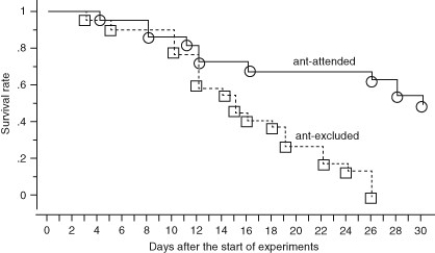
Which of the following conclusions is most likely correct?
A) Ants derive nourishment from the aphids.
B) Ants protect the aphids from predators.
C) Ants parasitize the aphids.
D) Ants feed the aphids.
Aphids are Hemiptera that suck phloem liquid from plants. Ants are often seen tapping the posterior end of the aphid and collecting the liquid that is released from the aphid's digestive system. In an effort to understand this interaction, several researchers measure the survival rates of aphid populations when ants were present and when they were excluded. Their results are shown.

Which of the following conclusions is most likely correct?
A) Ants derive nourishment from the aphids.
B) Ants protect the aphids from predators.
C) Ants parasitize the aphids.
D) Ants feed the aphids.

فتح الحزمة
افتح القفل للوصول البطاقات البالغ عددها 83 في هذه المجموعة.
فتح الحزمة
k this deck
77
The water vascular system of echinoderms
A) functions as a circulatory system that distributes nutrients to body cells.
B) functions in locomotion and feeding.
C) is bilateral in organization, even though the adult animal is not bilaterally symmetrical.
D) moves water through the animal's body during filter feeding.
A) functions as a circulatory system that distributes nutrients to body cells.
B) functions in locomotion and feeding.
C) is bilateral in organization, even though the adult animal is not bilaterally symmetrical.
D) moves water through the animal's body during filter feeding.

فتح الحزمة
افتح القفل للوصول البطاقات البالغ عددها 83 في هذه المجموعة.
فتح الحزمة
k this deck
78
The increase in plant species diversity allowed which of the following events?
A) the evolution of complete metamorphosis in insects
B) the evolution of flight in insects
C) invasion of marine habitats by insects
D) a massive increase in species diversity of insects
A) the evolution of complete metamorphosis in insects
B) the evolution of flight in insects
C) invasion of marine habitats by insects
D) a massive increase in species diversity of insects

فتح الحزمة
افتح القفل للوصول البطاقات البالغ عددها 83 في هذه المجموعة.
فتح الحزمة
k this deck
79
Use the following information to answer the question.
Nudibranchs, a type of predatory sea slug, can have various protuberances (that is, extensions) on their dorsal surfaces. Rhinophores are paired structures, located close to the head, which bear many chemoreceptors. Dorsal plumules, usually located posteriorly, perform respiratory gas exchange. Cerata usually cover much of the dorsal surface and contain nematocysts at their tips.
The antennae of insects have a function most similar to that of ________.
A) rhinophores
B) dorsal plumules
C) cerata
D) chemoreceptors
Nudibranchs, a type of predatory sea slug, can have various protuberances (that is, extensions) on their dorsal surfaces. Rhinophores are paired structures, located close to the head, which bear many chemoreceptors. Dorsal plumules, usually located posteriorly, perform respiratory gas exchange. Cerata usually cover much of the dorsal surface and contain nematocysts at their tips.
The antennae of insects have a function most similar to that of ________.
A) rhinophores
B) dorsal plumules
C) cerata
D) chemoreceptors

فتح الحزمة
افتح القفل للوصول البطاقات البالغ عددها 83 في هذه المجموعة.
فتح الحزمة
k this deck
80
Use the following information to answer the question.
Nudibranchs, a type of predatory sea slug, can have various protuberances (that is, extensions) on their dorsal surfaces. Rhinophores are paired structures, located close to the head, which bear many chemoreceptors. Dorsal plumules, usually located posteriorly, perform respiratory gas exchange. Cerata usually cover much of the dorsal surface and contain nematocysts at their tips.
The stingers of honeybees have a function most similar to that of ________.
A) rhinophores
B) dorsal plumules
C) cerata
D) chemoreceptors
Nudibranchs, a type of predatory sea slug, can have various protuberances (that is, extensions) on their dorsal surfaces. Rhinophores are paired structures, located close to the head, which bear many chemoreceptors. Dorsal plumules, usually located posteriorly, perform respiratory gas exchange. Cerata usually cover much of the dorsal surface and contain nematocysts at their tips.
The stingers of honeybees have a function most similar to that of ________.
A) rhinophores
B) dorsal plumules
C) cerata
D) chemoreceptors

فتح الحزمة
افتح القفل للوصول البطاقات البالغ عددها 83 في هذه المجموعة.
فتح الحزمة
k this deck








